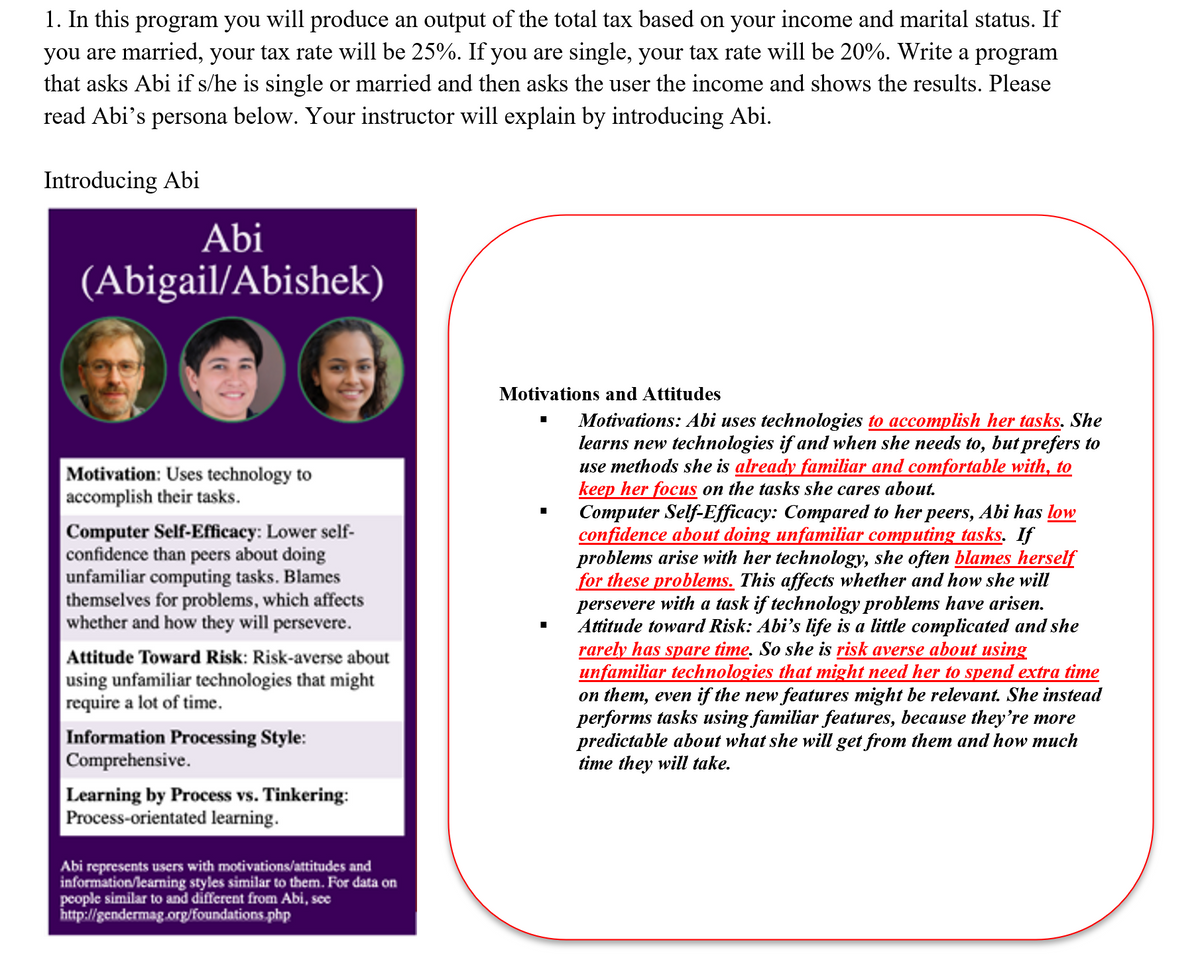In this program you will produce an output of the total tax based on your income and marital status. If you are married, your tax rate will be 25%. If you are single, your tax rate will be 20%. Write a program that asks Abi if s/he is single or married and then asks the user the income and shows the results. Please read Abi’s persona below.
In this program you will produce an output of the total tax based on your income and marital status. If you are married, your tax rate will be 25%. If you are single, your tax rate will be 20%. Write a program that asks Abi if s/he is single or married and then asks the user the income and shows the results. Please read Abi’s persona below.
C++ Programming: From Problem Analysis to Program Design
8th Edition
ISBN:9781337102087
Author:D. S. Malik
Publisher:D. S. Malik
Chapter5: Control Structures Ii (repetition)
Section: Chapter Questions
Problem 19PE
Related questions
Question
- In this
program you will produce an output of the total tax based on your income and marital status. If you are married, your tax rate will be 25%. If you are single, your tax rate will be 20%. Write a program that asks Abi if s/he is single or married and then asks the user the income and shows the results. Please read Abi’s persona below.

Transcribed Image Text:1. In this program you will produce an output of the total tax based on your income and marital status. If
you are married, your tax rate will be 25%. If you are single, your tax rate will be 20%. Write a program
that asks Abi if s/he is single or married and then asks the user the income and shows the results. Please
read Abi's persona below. Your instructor will explain by introducing Abi.
Introducing Abi
Abi
(Abigail/Abishek)
Motivation: Uses technology to
accomplish their tasks.
Computer Self-Efficacy: Lower self-
confidence than peers about doing
unfamiliar computing tasks. Blames
themselves for problems, which affects
whether and how they will persevere.
Attitude toward Risk: Risk-averse about
using unfamiliar technologies that might
require a lot of time.
Information Processing Style:
Comprehensive.
Learning by Process vs. Tinkering:
Process-orientated learning.
Abi represents users with motivations/attitudes and
information/learning styles similar to them. For data on
people similar to and different from Abi, see
http://gendermag.org/foundations.php
Motivations and Attitudes
■
■
Motivations: Abi uses technologies to accomplish her tasks. She
learns new technologies if and when she needs to, but prefers to
use methods she is already familiar and comfortable with, to
keep her focus on the tasks she cares about.
Computer Self-Efficacy: Compared to her peers, Abi has low
confidence about doing unfamiliar computing tasks. If
problems arise with her technology, she often blames herself
for these problems. This affects whether and how will
persevere with a task if technology problems have arisen.
Attitude toward Risk: Abi's life is a little complicated and she
rarely has spare time. So she is risk averse about using
unfamiliar technologies that might need her to spend extra time
on them, even if the new features might be relevant. She instead
performs tasks using familiar features, because they're more
predictable about what she will get from them and how much
time they will take.
![2. After your wrote the program, answer the following questions.
2a. How would you verify the user input, married or single, nothing else?
Explain.
2b. Would you allow an Income input less than 0?
Explain how you would design your program to disallow the user to input a negative Income value?
2c. Would you allow Income input as a floating point number?
Explain how you would declare income variables.
2d. Would you allow Calculating the total tax as a floating-point number?
Explain how you would calculate the total tax.
CPS 1231 GenderMag Assignment
2e. For the output you provided, why (or why not) do you think Abi will be satisfied? Does it display
what Abi input (e.g. income and marital status)? See the sample run below and compare to yours. What
do you think Abi would be comfortable with and explain why? [This is part of the scoring rubric]](/v2/_next/image?url=https%3A%2F%2Fcontent.bartleby.com%2Fqna-images%2Fquestion%2F61035ffb-6e4a-4d45-8465-00f0eac1c289%2F1f76c314-d7c8-4f46-bdc9-70afed160fb6%2Fu2qjwzi_processed.png&w=3840&q=75)
Transcribed Image Text:2. After your wrote the program, answer the following questions.
2a. How would you verify the user input, married or single, nothing else?
Explain.
2b. Would you allow an Income input less than 0?
Explain how you would design your program to disallow the user to input a negative Income value?
2c. Would you allow Income input as a floating point number?
Explain how you would declare income variables.
2d. Would you allow Calculating the total tax as a floating-point number?
Explain how you would calculate the total tax.
CPS 1231 GenderMag Assignment
2e. For the output you provided, why (or why not) do you think Abi will be satisfied? Does it display
what Abi input (e.g. income and marital status)? See the sample run below and compare to yours. What
do you think Abi would be comfortable with and explain why? [This is part of the scoring rubric]
Expert Solution
This question has been solved!
Explore an expertly crafted, step-by-step solution for a thorough understanding of key concepts.
This is a popular solution!
Trending now
This is a popular solution!
Step by step
Solved in 3 steps with 1 images

Knowledge Booster
Learn more about
Need a deep-dive on the concept behind this application? Look no further. Learn more about this topic, computer-science and related others by exploring similar questions and additional content below.Recommended textbooks for you

C++ Programming: From Problem Analysis to Program…
Computer Science
ISBN:
9781337102087
Author:
D. S. Malik
Publisher:
Cengage Learning

C++ Programming: From Problem Analysis to Program…
Computer Science
ISBN:
9781337102087
Author:
D. S. Malik
Publisher:
Cengage Learning